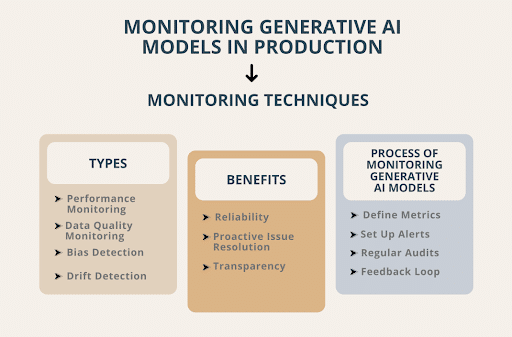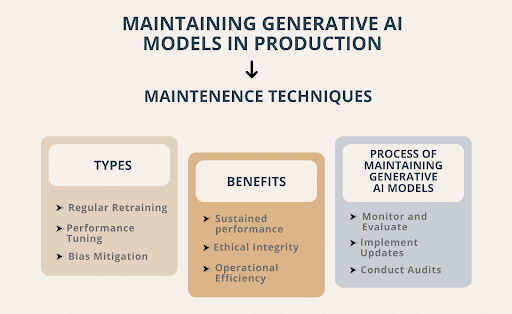Introduction
Artificial intelligence has seen a wide range of applications across various industries across the globe. This has been possible due to the deployment of generative AI models in production.
With AI model updates, generative AI models transformed the fields of natural language processing (NLP), computer vision, and entertainment.
Even though the generative AI models in production provide numerous benefits to businesses, leading to their success, the AI model deployment in the production environment is filled with many unique challenges.
It is therefore important to monitor and maintain the models for effective AI model management, which helps achieve optimal performance and ethical use and leads to improved AI model reliability throughout the AI model’s lifecycle.
In this blog, we will understand the various aspects of generative AI models in production along with the monitoring and maintenance techniques needed to ensure the AI model’s optimisation and performance.
Generative AI Models In Production
Before monitoring and maintaining generative AI models in production, it is important to understand the various aspects of generative AI models in production.
What are Generative AI Models in Production?
Generative AI models are basically advanced algorithms that are designed in a manner that helps the AI models generate new outputs that resemble the existing data on which the model is trained.
After the AI model deployment, the production AI models are used in real-world applications such as content creation (text, image, audio, and video), design and creativity, customer support, etc.
The deployment of generative AI models in production involves integrating the production AI models into existing business systems and workflows, where they gain the ability to interact with users, make decisions, and produce relevant outputs that help in various business processes.

Fig. 1
Uses of Generative AI Models in Production
Generative AI models in production have many uses that help various industries and organisations improve their processes and achieve huge success in the dynamic environment.
- Content Creation: Generative AI models help organisations automate the process of content creation (text, image, audio, and video). This helps organisations reduce the amount of time and effort required for content generation. As a result, organisations are able to generate high volumes of customer-friendly content that improves customer engagement and the organisation’s relevancy in the dynamic digital landscape.
- Customer Service: Generative AI models in the form of chatbots and virtual assistants help organisations provide personalised and efficient customer support by handling various customer queries and resolving customer complaints without the need for human intervention. This helps to improve overall customer satisfaction and experience while improving the operational efficiency of the organisation.
- Healthcare: In the field of medical research, AI model performance has been extremely helpful as it helps in simulating biological processes, generating synthetic medical data for research purposes, and assisting in drug discovery. With AI model deployment, the healthcare industry has seen an acceleration in the development of new medical treatments and solutions, leading to improved patient outcomes.
Benefits of Generative AI Models in Production
Given below are some of the benefits of generative AI models in production:
- Efficiency: By automating the repetitive and time-consuming tasks of the organisation with production AI models, the organisation is able to significantly improve its efficiency while allowing its human resources to focus more on high-value and strategic tasks. This is extremely beneficial for the organisation as it helps in improving project turnaround time due to higher productivity and cost savings.
- AI Model Scalability: AI model scalability implies that the generative AI models in production are able to handle large volumes of data and interactions effectively and efficiently. As a result, such AI models are considered ideal for applications that require vast volumes of data, such as customer support and content creation. With AI model scalability, organisations are able to meet the growing demands of the market without compromising performance or quality.
- Cost Savings: As automating repetitive organisational tasks reduces the need for manual labour, it saves considerable costs for the organisation. Further, the AI models are expected to cause fewer errors as compared to human resources, thus, saving the cost of error correction for the organisation.
Challenges of Generative AI Models in Production
Given below are some of the challenges faced by generative AI models in production:
- Ethical Concerns: Generative AI models have the ability to create fake but realistic content that can be used to spread misinformation and can further be misused, raising many ethical concerns. Therefore, it is important for organisations to establish clear ethical guidelines and frameworks in their organisation to prevent the misuse of generative AI content while saving the integrity of the generated content.
- Resource Intensive: Generative AI model deployment and training requires significant computational resources and infrastructure. This is generally very costly for organisations in addition to being harmful to the environment. Therefore, organisations must conduct a feasibility analysis with the benefits and associated costs along with environmental considerations before deploying a generative AI model, leading to AI model optimization while reducing its carbon footprint.
- Data Privacy: Generative AI models deal with huge amounts of data that may be sensitive or include personal information. Therefore, handling and generating content with AI models involves significant privacy considerations. Therefore, it is important for organisations to protect user data, maintain trust and ensure data privacy by complying with data privacy regulations and implementing strong security measures, improving the AI model’s reliability.
Monitoring Generative AI Models In Production
After generative AI model deployment, it is very critical to ensure AI model monitoring to ensure AI model optimisation with improved performance and reliable and accurate data output.
Effective AI model monitoring helps to identify and address various issues, such as model drift detection, biases, and performance issues.
With regular monitoring, the organisation is able to gain insights into the behaviour of the generative AI models in production and is able to proactively make adjustments and improvements for optimal performance.

Fig. 2
Types of Monitoring Techniques
In order to facilitate effective AI model monitoring of generative AI models in production, organisations can choose the monitoring technique that is the most suitable as per their requirements.
- Performance Monitoring: Performance monitoring includes tracking the performance metrics of the generative AI models in production, such as accuracy, latency, and throughput. By measuring the performance metrics of the AI model, organisations can ensure that the model meets its predefined standards and SLA requirements. Further, performance monitoring helps organisations to identify deviations from the expected behaviour of the model, providing timely interventions that help to address performance issues.
- Data Quality Monitoring: It is important for organisations to ensure that the quality of input data is high, as if the quality of input data is poor, it can lead to incorrect and biased outputs. Data quality monitoring involves monitoring for anomalies, missing data, and data distribution changes. With high-quality input data, organisations can ensure that the generative AI models in production generate data that is accurate and reliable.
- Bias Detection: It is critical to monitor the biases in the generative AI models in production to ensure that the output generated is fair and prevents discriminatory practices. For this, organisations can use various bias monitoring techniques, such as fairness audits and bias detection tools. With regular bias detection, organisations can ensure that their models operate in an ethical and equitable manner.
- Model Drift Detection: Model drift is the process where the statistical properties of the input data into the generative AI models in production change over time, affecting the performance of the model. Model drift detection involves monitoring data and model performance to identify and address the model drift. With the help of drift detection, generative AI models are able to maintain the accuracy and relevance of the model over time.
Benefits of Monitoring Techniques
Given below are some of the benefits of monitoring techniques that help to maintain the AI model’s health:
- AI Model Reliability: With the help of AI model monitoring, organisations are able to improve AI model reliability, improving the trust and confidence for the generative AI models in production amongst the users and stakeholders. If the generative AI model is reliable, it can improve overall user satisfaction and help the AI application succeed.
- Proactive Issue Resolution: Through AI model monitoring, organisations are able to detect issues early in the process, leading to a proactive resolution that helps prevent potential operational disruptions. With proactive issue resolution, organisations are able to ensure smooth organisational operations by maintaining the continuity and effectiveness of the generative AI models in production.
- Transparency: As AI model monitoring helps to provide transparency into the behaviour and performance of the production AI models, it leads to a better understanding and accountability of the generative AI models in production. Transparency helps to build the trust of users and stakeholders with respect to the performance of the AI model.
Process of Monitoring Generative AI Models
AI model monitoring helps to improve the AI model’s reliability, performance, and optimisation throughout the AI model’s lifecycle.
Given below are the steps that are used to complete the process of monitoring generative AI models in production:
- Define Metrics: This step involves establishing clear and relevant metrics for monitoring generative AI models in production to ensure their performance, fairness, and reliability. Through appropriate and defined metrics, organisations can ensure that their AI model monitoring process is focused and effective, which measures all the necessary aspects of the performance of the model.
- Set Up Alerts: After defining the metrics for AI model monitoring, organisations can implement alerting mechanisms that notify stakeholders about any performance issues or anomalies that the generative AI model might face. With the help of alerts, organisations can ensure timely interventions and corrective actions that help prevent potential disruptions in the organisational operations while maintaining the AI model’s reliability.
- Regular Audits: Effective monitoring of generative AI models in production can be achieved by conducting regular audits and reviews of the outputs and performance of the production AI models. This helps to ensure that the organisation complies with all the required standards and objectives. Through regular audits, organisations can identify and address all the emerging issues of the generative AI model while ensuring that the generative AI model remains relevant, effective, and compliant.
- AI Model Feedback Loops: Organisations must create AI model feedback loops that ensure that the monitoring results are included in AI model updates and improvements. With the help of AI model feedback loops, organisations can ensure that there is continuous learning, improvement, and adaptation of the generative AI models, which helps to maintain the relevance and effectiveness of the AI model over time.
Maintaining Generative AI Models In Production
It is crucial to maintain generative AI models in production to ensure their effective performance while adapting to the various changing requirements and environments in the dynamic digital landscape.
AI model maintenance is important to address the numerous issues of the generative AI model, such as model drift, performance degradation, and potential or emerging biases. By addressing such issues, organisations are able to maintain the generative AI model’s compliance, relevance, and longevity.

Fig. 3
Types of Maintenance Techniques
Given below are some of the maintenance techniques that are used for generative AI models in production:
- Regular Retraining: If an organisation periodically retrains its AI model with updated data, they increase the probability of improving its accuracy and relevance while addressing any drifts or changes in data patterns. With the help of regular retraining, the model is able to adapt to new information which helps the AI model to continue to produce accurate and relevant outputs.
- Performance Tuning: With the help of performance tuning, organisations can adjust the hyperparameters of the AI model while achieving the optimisation of the architecture of the AI model. This helps to improve the performance and efficiency of the AI model. Performance tuning helps to maximise the capabilities of the AI model, ensuring that the model operates at its best capability, leading to the delivery of high-quality results.
- Bias Mitigation: By ensuring AI model maintenance and implementing various techniques for the same, organisations are able to ensure fairness and ethical use of the AI model by detecting and mitigating biases in the model’s outputs.
Benefits of Maintenance Techniques
The various benefits that the organisation achieves with AI model maintenance include:
- Sustained Performance: With the help of regular maintenance, the generative AI models in production are able to perform at their best abilities, leading to the continuous delivery of reliable and consistent results. Through sustained performance, organisations are able to achieve overall success and effectiveness with respect to their generative AI models in production.
- Ethical Integrity: Through AI model maintenance, organisations are able to address the biases in the AI models and ensure fairness, helping to uphold the ethical standards of the AI systems. With the help of ethical integrity, the organisation is able to build the trust of its users and stakeholders, hence improving the overall reputation of the organisation.
- Operational Efficiency: Generative AI models in production that are well-maintained help to improve the overall efficiency and effectiveness of the organisational operations as they reduce downtimes and improve productivity. Further, by achieving operational efficiency, the organisation prospers as it is able to move towards its goals and maintain a competitive advantage in the dynamic market.
Process of Maintaining Generative AI Models in Production
The process of maintaining generative AI models in production includes the following steps:
- Monitor and Evaluate: This includes continuously monitoring the performance of the AI model and evaluating its outputs to identify areas of improvement. With the help of regular monitoring and evaluation, organisations are able to detect issues early on and mitigate them to ensure that the AI model operates at its best.
- Implement Updates: Organisations must regularly update the generative AI model with new data and implement various performance improvements to keep the model relevant and efficient. Further, by implementing updates, the model is able to remain up-to-date with the latest information, leading to accurate and relevant results.
- Conduct Audits: Periodic audits and reviews ensure that the AI model performs in adherence to required ethical and compliance standards. Through regular audits, organisations are able to identify and address emerging issues, which helps to maintain the integrity and reliability of generative AI models in production.
Conclusion
With generative AI model deployment in production, various industries are transformed due to the numerous capabilities that it brings to the table.
Having said that, it is extremely important for organisations to closely monitor and regularly maintain the generative AI models in production to ensure their optimal performance, reliability, and ethical use.
For organisations that wish to be successful in the digital landscape, it is important to stay informed and implement the best monitoring and maintenance practices for generative AI models in production in order to fully utilise the benefits of generative AI in the production environment.
We at CrossML, with our team of AI experts, help organisations implement and integrate the best monitoring and maintenance practices for their AI models. This helps organisations with seamless workflows, improving their efficiency and productivity and hence helping them to achieve newer heights of success and competitive advantage in the dynamic market.
FAQs
Generative AI models can be used in production for automating content creation (text, image, audio, and video), improving customer service with the help of chatbots, helping in designing and creativity, and aiding in the healthcare industry by simulating biological processes and helping in drug discovery. Further, generative AI models are also able to personalise user experiences, streamline operations, and help drive innovation across various sectors and industries while improving efficiency and engagement.
The various benefits of implementing generative AI include increased efficiency due to the automation of repetitive organisational tasks, scalability capabilities that help in seamlessly handling large volumes of data, personalising user experiences and improving overall user satisfaction, improved creativity and innovation, and significant cost savings for the organisation. Further, organisations can also help organisations by improving the overall decision-making process, boosting operational performance, and maintaining a competitive advantage in the ever-evolving and dynamic markets.
The best practices for deploying generative AI include thorough and robust testing and validation, continuous monitoring of performance and biases, regular updates and retraining with new data, ensuring that the data quality is high, implementing ethical guidelines, and maintaining transparency with all the stakeholders. It is also essential for organisations to have strong security measures in place, along with compliance with data privacy regulations that help to protect user information.
Generative AI models differ from other AI models as generative AI models, unlike other AI models or discriminative models, are specifically designed to generate new data (text, image, audio, and video) that resembles the data that they have been trained on. The generative AI models focus on learning the underlying distribution of the training data to produce new outputs, whereas the other AI models typically classify or predict output data based on input data. Examples of generative AI models include GANS, VAEs, and transformer models.
The various industries that can benefit from generative AI technology include the healthcare industry (helps in medical research and diagnostics), the entertainment industry (helps in content creation and virtual reality), the e-commerce industry (helps to provide personalised recommendations), the customer service industry (by helping through AI chatbots), the design industry (helps in creative automation), and the finance industry (helps in risk assessment and fraud detection).


